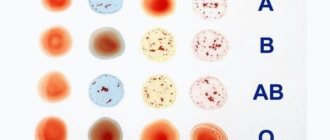1
Author of the article: Marina Dmitrievna
2017.10.03
2 030
Blood analysis
A person rarely thinks about what kind of blood he has. This question arises when necessary: transfusion to him as a recipient, donation for caring people, or when planning a child - conception, gestation and intrauterine development of the baby. Then it turns out that not all blood is suitable. The main determining criterion is not only the group, but also the Rh factor (Rh).
How does the Rh factor of parents affect the child?
It is known that if a woman has a Rh factor of “-” and a man has a Rh factor of “+,” then a serological conflict arises.
How does the Rh factor affect the unborn child?
Serological conflict is a disorder primarily affecting women with the Rh- blood type who have children with an Rh+ male. This phenomenon causes hemolytic disease of the fetus or newborn. The essence of the problem lies in the mother's production of antibodies that destroy the fetus's red blood cells. This leads to anemia and many other serious complications.
It should be noted that a serological conflict rarely occurs during the first pregnancy, since the mother's immune system does not yet produce antibodies to the Rh factor.
Rh conflict during pregnancy appears no earlier than 16 weeks after conception. If antibodies are not detected by 20 weeks of pregnancy, they are unlikely to appear.
Rhesus - conflict resembles a mechanism of defense against viruses, when resistance is formed by the immune system to destroy the “enemy”. While in the case of pathogenic microorganisms the phenomenon has a beneficial effect, in the case of a serological conflict the effect is completely opposite, since it causes pathological conditions in the child.
As a result of inheritance, the fetus receives antigenic characteristics from both the mother and the father. During pregnancy, due to the penetration of fetal blood cells into the mother's blood circulation with the antigenic characteristics of the father (which the mother does not have), the mother begins to produce antibodies directed against these antigens.
The most famous and important example of serological conflict is the difference in Rh cell antigens in the fetus and mother. The formation of antibodies in a woman's circulation occurs when the fetus inherits the father's "D" (Rh+) antigen and the mother has the "d" (Rh–) antigen.
The resulting antibodies to the Rh factor enter the baby's circulation and cause damage to blood cells, leading to hemolytic disease.
The mildest form of hemolytic disease is the destruction of a child's blood cells. The child is born with anemia, which is usually accompanied by an enlarged spleen and liver, but this does not pose a threat to his life. Over time, the blood picture improves significantly and the child develops correctly. However, it should be emphasized that in some cases anemia is severe and requires special treatment.
Neonatal jaundice is another form of hemolytic disease. The baby looks quite healthy, but on the first day after birth, a jaundiced color of the skin begins to appear. There is a very rapid increase in bilirubin, which has a toxic effect on the child’s brain and liver.
The final and most serious form of hemolytic disease of the newborn is generalized fetal edema. As a result of the destruction of the baby's blood cells by the mother's antibodies (still at the stage of intrauterine life), blood circulation is disrupted and vascular permeability increases. What does it mean? Fluid from the blood vessels leaks into nearby tissues, causing internal swelling to form in important organs, such as the peritoneum or the pericardial sac that surrounds the heart. Unfortunately, edema is such a serious pathological condition that it usually leads to the death of the child in the womb or immediately after birth.
Blue blood
All members of royal families prefer to marry their relatives to maintain their bloodline. This is because all of these people are Rh negative, which they plan to keep. For example, Queen Elizabeth II is married to her cousin Prince Philip.
Rh negative was also present in American presidents: Barack Obama, John Kennedy, George Bush Sr., Bill Clinton.
Found a violation? Report content
Rhesus conflict: why does this happen?
Each person has a blood type (O, A, B or AB), and also has a Rh factor (positive or negative), a protein that coats red blood cells. If the protein is on the cells, the person is Rh positive; if not, the person is Rh negative. In this case, the child may have the blood type and Rh factor of one of the parents or a combination of both.
The difference in blood type between a pregnant woman and her child causes Rh incompatibility. The condition occurs if a woman is Rh negative and her baby is Rh positive.
A serological conflict occurs when a small amount of the baby's blood enters the mother's bloodstream for the first time. This usually only occurs during childbirth, because the blood of the baby and mother do not mix during pregnancy due to the placental barrier between them; however, this can occur as a result of miscarriage, intrauterine surgery, bleeding, ectopic pregnancy, etc. When Rh (+) blood cells enter the mother's bloodstream, her body begins to produce antibodies (such as IgM and IgG) against the D-antigen present on the red blood cells of the fetus. These antibodies can cross the placenta and attack the baby's red blood cells, leading to the development of hemolytic anemia.
Once Rh antibodies have been formed, they remain forever in the woman’s body. As a result, all subsequent pregnancies with an Rh-positive child are at greater risk of developing hemolytic anemia and other pathologies.
Earth aliens
The appearance of people with negative Rh is a mystery to scientists. It has been proven that there are no more than fifteen percent of them around the globe. They do not have a special protein in their blood that all people born on the planet have. Since humans arose from common ancestors, where did Rh negative come from? There is an assumption that such people arose as a result of the interaction of beautiful representatives of the Earth and representatives of other civilizations.
I've never thrown away ice cream containers: a friend told me not to use them.
A rare 1932 Ford is being sold in Illinois for $4,300 in disassembled condition.
Grandparents built a “park” for their granddaughter on an old playground
Confirmation of this hypothesis of scientists is the Bible, the Koran, and the Talmud, which describe the presence of angels who descended from heaven (they are called fallen).
What are the consequences for mother and child?
For a pregnant woman, the development of a serological conflict does not threaten her in any way and does not affect her health in any way, which cannot be said about a child. A serological conflict can cause severe hemolytic disease (erythroblastosis fetalis), brain damage, hypoxia, and damage the central nervous system, liver and kidneys. For this reason, such a pregnancy requires careful medical monitoring.
Does blood group compatibility affect conception and gender of a child?
When planning a child, parents need to know their own blood type and Rh factor. This is important information that can affect both the course of pregnancy and the health of the unborn child.
Is blood group and Rh factor compatibility so important? The blood type itself (if you do not take into account the Rh factor) does not in any way affect the process of conception, the course of pregnancy or the gender of the child. In the practice of any reproductive specialist, there is more than one case where parents with different blood groups became parents of a healthy child.
Ideally, the Rh factor of both parents should match, otherwise there is a high risk of developing a serological conflict, when the mother’s body rejects the fetus as a foreign body.
Features
People with negative Rh and the first group are ideal donors. Their blood is universal for everyone and is therefore highly valued. But these people also have distinctive unique features. These include:
- excellent mental and analytical abilities;
- love of warmth;
- unique superpowers;
- hair with a reddish tint;
- low blood pressure and body temperature;
- the presence of additional ribs or vertebrae;
- cannot be cloned;
- most often (according to statistics) are abducted by aliens for the purpose of using biological material.
What to do if there is a Rh conflict?
If the expectant mother and fetus are threatened by the consequences of Rh conflict, she should be under constant medical supervision.
In addition to regular blood tests to assess antibody levels (the more, the worse for the baby), a pregnant woman with a serological conflict should constantly undergo ultrasound examination for any signs of hemolytic disease of the fetus. Ultrasound examination allows you to measure blood flow in the artery of the child’s brain and assess the condition of the amniotic fluid and placenta. If anemia is suspected, the doctor prescribes additional diagnostic measures, most often cordocentesis. This is an accurate and commonly used test to obtain cord blood. Under ultrasound control, the umbilical vessels are dissected using a thin needle, after which about 0.5-1 ml of blood is taken. Such a blood test answers the question of what degree of anemia we are dealing with and what kind of blood the fetus has. This study allows you to plan further procedures.
Decoding
The tests are carried out in such a way that the result is visible under a microscope in the form of a biochemical agglutination reaction (clumping of red blood cells and their precipitation, followed by clarification of the liquid). If clots formed under the influence of the solution and settled to the bottom of the test tube, then the material under study has a positive Rh factor. If there are no changes, the parameter value is considered negative.
Important information: Which blood type is considered the best (good) in a person?
The Rh factor is simply designated: Rh(+) and Rh(-). No tables are required when decoding, since no significant measurements are made.
Can incompatibility be cured?
Unfortunately, treatment of incompatibility is impossible, but, nevertheless, even with such a diagnosis there is a chance to carry and give birth to a healthy child.
The most important thing is the prevention of serological conflict and its early diagnosis. The expectant mother should be closely monitored by a doctor to undergo blood tests every few weeks, check antibody levels and check the intrauterine development of the fetus using ultrasound.
Most gynecologists, when identifying this phenomenon, prescribe the use of anti-D-immunoglobulin, which is administered by injection between 28 and 32 weeks of pregnancy, which increases the likelihood of avoiding the consequences of the conflict. A repeat dose is given 72 hours before the baby is born. After this time, the anti-D immunoglobulin vaccine will no longer serve its purpose. Administration of immunoglobulin during the first pregnancy often saves the life of the second child. The vaccine is also given after a miscarriage, abortion, amniocentesis, cesarean section, or bleeding during labor.
What else can a child inherit?
- Mendel's laws state that parents with the first blood group will produce children without A- and B-types.
- If the husband and wife have the first and second, then the children will have the same blood types. The situation is similar with the first and third groups.
- People with the fourth group may have children with either the second, or the third, or the fourth, but not the first. In this case, the partner’s antigens have no effect.
- If the parents have the second and third groups, then the child’s group is absolutely impossible to predict. Their children can become owners of any group of four.
- But where without exceptions. There are people who have A and B ant in their phenotype, but they do not manifest themselves. Such cases are very rare, and often among Hindus, which is why they are called the “Bombay phenomenon.”
For many centuries, parents have fantasized about what their child might be like. Today, thanks to ultrasound, you can look into the future and find out what gender the child will be, see the anatomical and physiological characteristics of the baby.
With the help of genetics, you can predict the color of a child’s eyes and hair, and the likelihood of having an ear for music. These traits are divided into dominant and recessive, and the probability of inheritance can be determined using Mendel’s laws. Dominant characteristics include brown eyes, curly hair, and the ability to curl the tongue into a tube. They have a very high probability of inheritance.
Unhappy, but also dominant signs include early baldness and graying, gaps between the front teeth, and myopia.
Blue or gray eyes, straight hair, light skin, and an average ear for music are recessive traits that are less likely to be inherited.
Modern technologies make it easier to determine the phenotype (hair and eye color) of the unborn child. It is also now possible to determine the physiological and anatomical characteristics of the baby during its development in the womb. Phenotypic traits also depend on blood type inheritance.
According to statistics, children are least likely to inherit from their parents:
- fair skin;
- blue or gray eyes;
- soft straight hair.
Rarity of inheritance
Evolution of discoveries - the birth of an answer gives rise to questions
Meanwhile, types A and B had just begun to plague humanity by the time blood transfusions and organ transplants occurred. Again, the immune system attacked the strangely saturated blood cells and caused medical problems. Type O patients, approximately forty-five percent of the population, could donate their blood and organs, but could not receive anything suitable in return in case of emergency. The blood resonance factor depended on what type of medical procedure was performed.
Technically, it depends on the fact that people are divided by blood type. Genes don't change. However, scientists noticed that after bone marrow transplantation, "regenerated patients" sometimes slowly developed the donor's blood types. Bone marrow was used to create one type of blood, but slowly filled people with cells that didn't match their genotype. It made sense to establish the fact of organ rejection.
Boy or...
For many centuries, the blame for the lack of an heir in the family was placed on the woman. To achieve the goal of having a boy, women resorted to diets and calculated favorable days for conception. But let's look at the problem from a scientific point of view. Human sex cells (eggs and sperm) have half the set of chromosomes (that is, there are 23 of them). 22 of them are the same for men and women. Only the last pair is different. In women these are XX chromosomes, and in men they are XY.
So the probability of having a child of one sex or another depends entirely on the chromosome set of the sperm that managed to fertilize the egg. To put it simply, the father is entirely responsible for the gender of the child!











